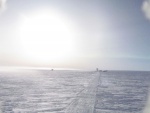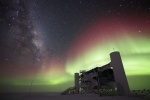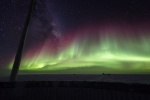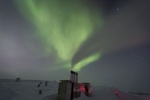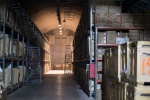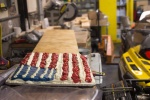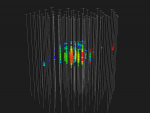Thursday, August 28, 2014 - 10:30am
Kids, don’t try this at home. At least not without proper equipment. Here some winterovers are learning to use what they call the “confidence chair,” a specialized piece of equipment for evacuating injured people from multilevel buildings.
Tuesday, August 19, 2014 - 3:45pm
Sun or moon? From the photo it’s hard to tell. It sure looks like a bright sunny day, but this is the South Pole, where it’s still winter and the sun has not yet returned.
Tuesday, August 12, 2014 - 5:30pm
UW–Day at the Wisconsin State Fair last Wednesday drew crowds of badger fans to Milwaukee, Wisconsin, for a day of hands-on activities.
Tuesday, August 12, 2014 - 3:15pm
It’s the photographer’s trifecta for wintering at the South Pole—a shot of the sky with a star-studded background, a nice aurora effect, and the Milky Way visible. You can’t beat that.
Monday, August 4, 2014 - 2:00pm
The auroras tell you it’s winter at the South Pole—you can’t see auroras there during the summer because the sun is out the whole time. But in winter, the folks who station at the South Pole get to witness these auroras in all their glory.
Tuesday, July 29, 2014 - 10:45am
It looks as if the smoke stacks are releasing a plume of green smoke along with their stream of exhaust, but it’s just an artifact of the camera angle. The green splash across the sky reminds us that it’s still aurora season at the South Pole.
Tuesday, July 29, 2014 - 9:00am
The 2014 annual meeting of the DM-Ice Collaboration, hosted today by WIPAC, brings together a dozen of its members to discuss current status and future development of the dark-matter detector at the South Pole.
Tuesday, July 22, 2014 - 10:30am
Winter is long at the South Pole, at least when measured by the last plane out and the first plane back in. That’s roughly eight to nine months with no one (and no things) coming or going, quite a long period of isolation for the 40 or so winterovers at the station.
Tuesday, July 15, 2014 - 9:00am
How to make any 4th of July celebration special:
Thursday, July 10, 2014 - 2:00pm
How is it possible to distinguish a neutrino produced by the interaction of cosmic rays in the Earth’s atmosphere from an astrophysical neutrino when the particles themselves are identical? The idea is simple enough: atmospheric neutrinos are always produced together with other particles, including muons.


